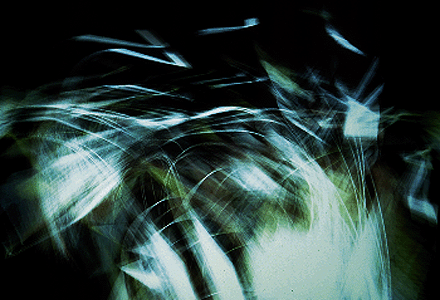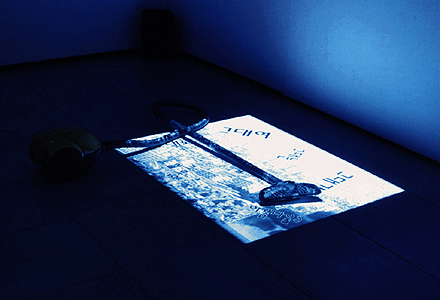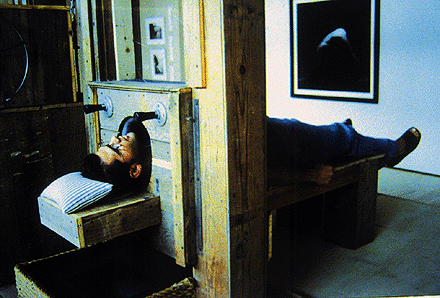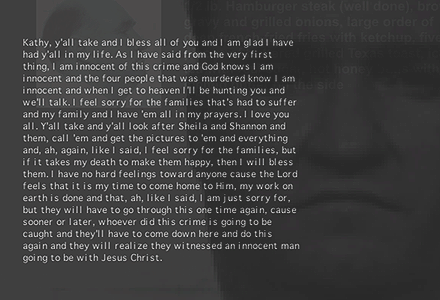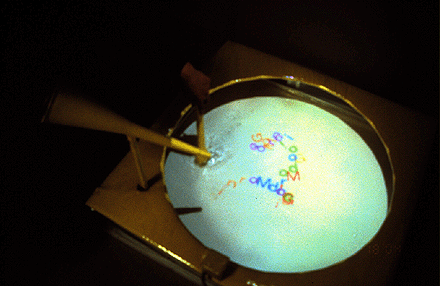Far away from the buzzing SIGGRAPH floor is the art gallery where high tech meets fine art. Annick Teninge reports on this fascinating realm.
Located in its own area, set up like a museum, SIGGRAPH's Art Gallery is known as a place where one can find works of art that capture the curiosity, even if one hasn't any idea what it's about. The gallery features a variety of art installations created with old and new graphics technologies that embody original ideas -- works that intrigue viewers and make them a part of the experience. This year, a fair amount of the art pieces combined images and sounds in creative and technically challenging installations.
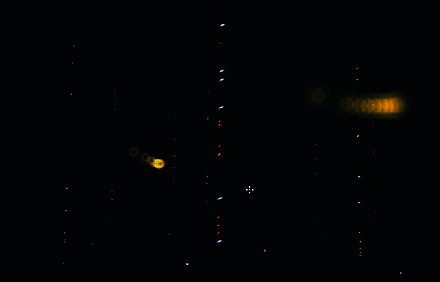
Bubbles represent sound components in James Lane/squidsoup's Altzero3. All images courtesy of the artist and SIGGRAPH 2001.
Music and Art
Altzero3 (www.squidsoup.com, Squid Soup, UK) is a spatial composition that allows one to explore subtleties and variations in sound by moving through an environment where lines of bubbles rise toward the surface, each representing a single sound component. There are fifty distinct sounds within the environment, designed and positioned to create a rich, complex chord that develops smoothly over time.
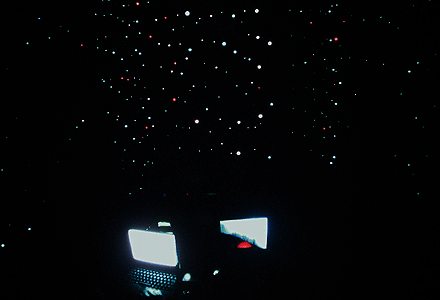
Haruo Ishii creates a harmonious chord out of hundreds of bells in his sound installation Omnipresence Version 4.
Omnipresence Version 4 (Haruo Ishii, Japan) is a sound installation where hundreds of bells send out different sounds but form an organic and harmonious chord, symbolizing a sort of multidimensional perspective of the cosmos.
Music Creatures (www.media.mit.edu, Marc Downie, USA) is a harmonious installation consisting of autonomous, virtually embodied characters living within a sonic environment. The movement of their graphic bodies, visualized on a computer screen, produces music on a piano and reflects their understanding of the sound that they hear. Computer movements and piano music are synthesized through the creatures' animal-inspired artificial intelligence.
Although somehow preposterous, some installations were quite amusing. In Poem Vacuum Cleaner (Eunmi Yang, South Korea) the floor is covered with poems coming from an overhead projector. When a viewer vacuums the poetic words, they turn into colorful projected flowers. According to the author, this work reflects on the role of a poem, which is a flower in our desolate urban existence. She commented that reading poems purifies feelings. It is ironic though that a vacuum symbolizes the act of reading.
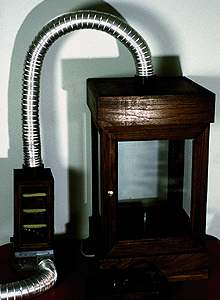
More cumbersome than a nicotine patch: The Smoker by Gene A. Felice II.
Social Commentary
The Smoker (www.novinicity.com/circuits, Gene A. Felice II, USA) is an interactive, robotic sculpture that simulates the lungs during the process of smoking. This is stressed by the sound of the author's own breathing and coughing, which can be heard as a pump in the sculpture breathes in and out. The speed of the breathing matches the speed of the pump, which is controlled by the viewer's interaction with another dial on the control box. While viewing steel factories with their smokestacks puffing out damaging byproducts, Felice conceived this sculpture. He combined this point of inspiration with the ongoing research he is conducting with interactive sculptures and their ability to create random byproducts through user interaction. Another goal of this piece, which was for him to quit smoking, has not worked out so well!
Case Study 5510/Case Study 5510-B (Tammy Knipp, USA) is a video-kinetic installation that captures people's facial expressions as they experience the simulation of a beheading machine. The installation consists of two 8-feet high guillotines mounted on a platform. Two people participate in an experiment where they lay down, face up, to view a wooden block actually dropping. The performance begins with a video image displayed on a monitor showing a rope unwinding -- virtually appearing to unwind. The 3D motion of a spinning wheel enhances the realism and builds a degree of anticipation. One and a half seconds after the video image of the rope unwinds the wooden blocks drop. Synchronized with the fall a concealed air compressor forces air around the neck of each participant. The participants' facial expressions are depicted live on two monitors mounted on a wall in a remote location of the gallery. The installation is described as "offering multiple perspectives and dialogues in the historical context of guillotines, control and technology as executor, monetary value [the guillotine is coin-activated] and entertainment at the expense of another's vulnerability." Maybe I missed something, but I wasn't intrigued or impressed by the technology and creativity of this convoluted installation. It didn't give me any historical perspective. The "unique language" was the universal, primary language of fear. As for the viewer's entertainment at the expense of another's vulnerability, the subjects themselves went for the thrill. I was much more impressed by the sharp simplicity of another work of art located next to Case Study 5510/Case Study 5510-B and dealing with the same topic.
Texas Moments (www.TexasMoments.com, Tarikh Korula, USA) is a screen saver featuring the 40 Death Row inmates executed by the state of Texas in the year 2000. Here, the fanciful images we have come to expect from screen savers are instead replaced by pictures of the inmates slowly scrolling by, following the content of their last meal. They cycle one after the other in the order in which they were executed. When a user rolls over an inmate's thumbnail image, a larger picture of him fades in with his final statement, or a blank message stating that the offender declined to make a final statement. All images and texts were pulled from the Texas Department of Criminal Justice Website.
Genius!
By far, the most popular displays in the Art Gallery were The Floating Words and Contact Water, two Japanese installations playing with virtual reality and how it affects our senses. The Floating Words (Satoko Moroi, Japan) is a mischievous installation playing with (what else!) words. When a viewer speaks into a microphone, his words slowly flow out of a pipe into a pool and reform, with beautiful color letters falling one by one into the water. Using a stick or a ladle, the viewer can stir the letters or pour them back into the water, undistorted. The artist commented her main goal was to play a joke on people, who are surprised and happy with her trick. She also wanted to create a happy, warm space, like in our childhood. I was curious to know why she chose to display words in a visual and tactile way, as words represent verbal (abstract) communication. She explained that her motivation was primarily to play with the sense of touch. She didn't want the material that flows out of the pipe to take shape as fish, which is what would be expected in water. Instead she decided to use letters and yet give the illusion that letters had substance, like fish. She was really pleased when a viewer asked if the letters were edible!
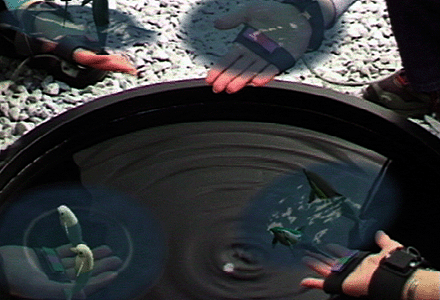
High tech toys allow participants to play games and explore nonverbal communication in Taisuke Murakami's Contact Water.
Contact Water (www.iamas.ac.jp/~taisum98, Taisuke Murakami, Japan) is an interactive art installation using mixed reality (MR) technology, which merges the real and virtual words in real-time. Real world scenes are augmented with virtual world images (water and aquatic animals) synthesized by computer graphics. With Contact Water, each player is wearing a head-mounted video camera and a glove. The video camera incorporates a magnetic sensor detecting the head position and a pair of cameras capturing real world information. The glove is equipped with a magnetic sensor, to follow the player's hand movements, and a speaker to output the whistles and squeaks of the aquatic animals. Each player can visualize a computer-generated water surface on his palm and get aquatic animals such as dolphins from a fountain in the center of the playfield. The animals display various gestures following the player's orders, given via hand movements. A player can also interact with other players by exchanging animals, i.e. throwing animals at another player while looking at him (the animals jump through a ring of particles to the other player's palm). This installation was very successful and visitors were queuing to play. The creator says he created this installation as a tool to enable people to see the importance of face to face communication, especially non-verbal communication through facial expressions and gestures. The awkwardness of the players in recreating and coordinating simple movements through virtual reality was in full agreement with the message... MR technology gets a lot of attention in Japan. The MR Lab, founded by the Japanese government and Canon, Inc., was launched in January 1997 as the core organization for promoting research projects on Mixed Reality systems. The goal is to apply MR technology to attractions at theme parks and exhibits at science museums, as well as home entertainment and wearable virtual city guides. Contact Water was awarded the grand prize at the first contest put together by the Mixed Reality Entertainment Conference (MREC) in 2000.
To me, the most intriguing aspect of Contact Water, as well as the other projects presented at SIGGRAPH this year, was the paradox between the technical sophistication of the work and the motivation of the artist, which was to go back to the essential, the most primary aspects of human relations and feelings.
After five years as AWN's General Manager Annick Teninge returned to France, where she is now in charge of production and distribution at La Poudrière in Valence, an animation school offering a 2-year program where students study the process of filmmaking and develop their own film projects. She is also heading AWN's marketing and public relations efforts in Europe. Annick began her animation career as assistant director at the Annecy International Animation Festival, a post she held for six years.
